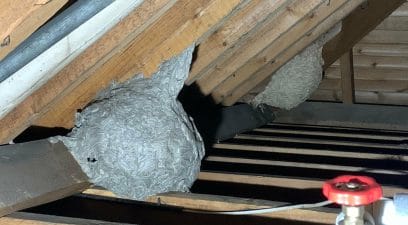As we head into Summer, we look forward to warmer weather, brighter evenings and garden BBQs. However, this enjoyment is cut short by the emergence of seasonal pests: wasps. These buzzing insects quickly become a nuisance, disturbing the peace and quiet with their obnoxious behaviour.
However, the hate towards wasps goes far beyond their annoying habits. Wasps are known for their unprovoked attacks, stinging adults, children and pets who get too close. With their aggressive behaviour, erratic movements and ability to sting multiple times, it’s no surprise that wasps are among the UK’s most feared and dangerous insects. In this blog, discover how to get rid of a wasp nest and restore peace to your home this Summer.
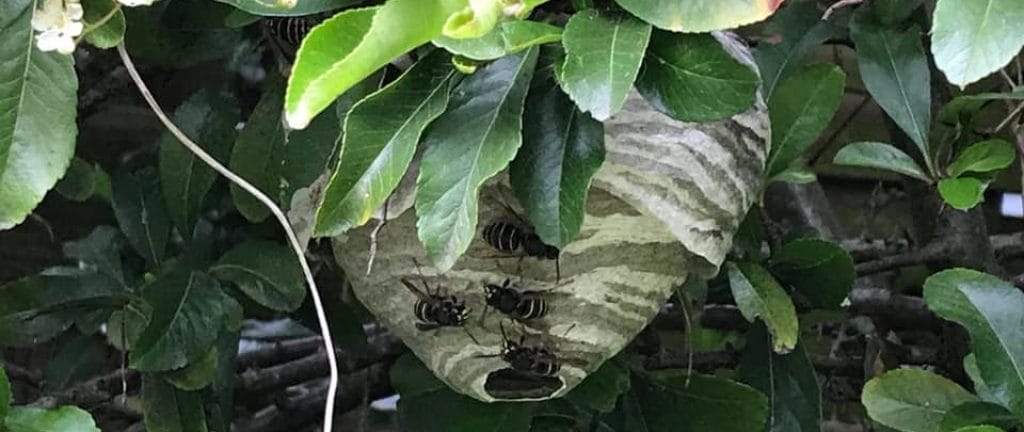
Wasp Behaviour
Wasps are a valuable and adaptable species, playing a crucial role in our ecology and environment, which go through several life cycle stages. Social wasps are essential pollinators and important predators against crop-eating insects, such as caterpillars and greenflies. There are over 7,000 different wasp species living in the UK. The most popular, which you are likely to see in your gardens or homes, are the common wasp (Vespula Vulgaris) and the German wasp (Vespula Germanica).
Categorised as eusocial, wasps live in large colonies of up to 15,000, working cooperatively to protect reproductive members. This can make tackling a wasp nest particularly difficult, as the colony will do whatever it takes to save its queen wasp. Additionally, the location of a wasps nest can make them difficult to treat as they are commonly found in trees, wall cavities, lofts, eaves, sheds and air bricks.
How Long Do Wasps Live?
The wasp season is typically between April and October, and the colony will begin to die as the weather cools. Although this sounds like your problem would be resolved naturally, queen wasps will actually reproduce new queens that will hibernate throughout Winter. Therefore, professional intervention is recommended to control the existing colony, exterminate the queen and minimise your chance of an infestation next year.
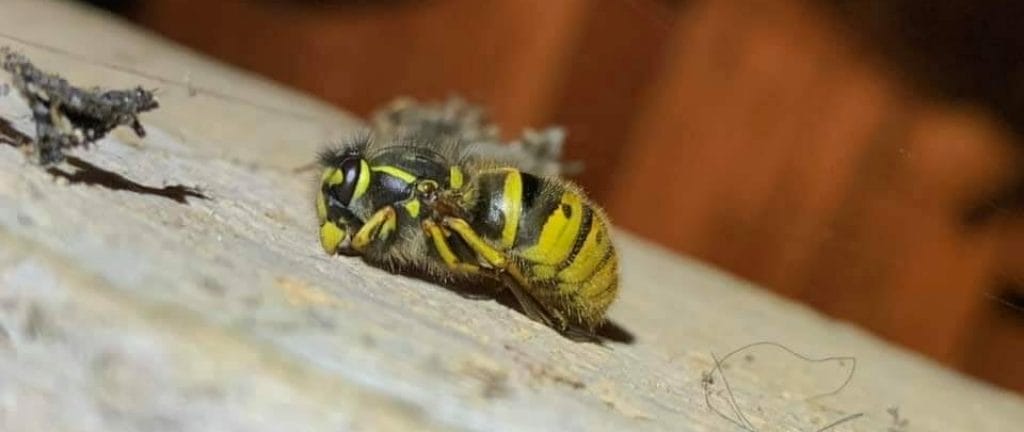
How to get rid of wasps?
Early pest detection and efficient wasp removal are vital in safeguarding your family and property. Read our blog post, signs of a wasp nest, to understand what you need to look out for in and around your home.
Once you have located a wasp nest, your first instinct may be to buy a can of insect spray and try to tackle the nest yourself. Although this seems like the easiest, quickest and cheapest way of handling the problem, it is a challenging task that requires training, PPE and expertise.
1. Call A Professional Pest Control Company
The safest and most guaranteed way of removing wasps from your property is by enlisting the help of a professional. Pest controllers host a wealth of experience and knowledge, understanding wasps’ behaviour and habits to implement effective treatments. This strategic approach to pest control guarantees complete eradication of wasps, nest removal and property proofing to reduce the chances of a future pest problem.
What can you expect from a professional service?
- Trained technicians, equipped for all wasp nest sizes and locations
- Full PPE for safe removal and disposal of wasps
- Guaranteed first-time results
- Cost-effective treatments
If you are in Kent and struggling with a wasp problem, call Pest-Tech today at 01622 296055 to schedule your wasp nest removal treatment.
2. DIY Wasp Nest Removal
If you still believe you can tackle the infestation yourself, here are some essential things to consider to execute it safely.
Timing: The earlier in the wasp season, the smaller the nest will be. Try to tackle the nest in early Spring/ Summer before it grows. However, regardless of the size, you should control the wasp nest early in the morning or late at night when the colony is less active and at its weakest.
Exit Strategy: If something goes wrong, ensure you have an escape route to get yourself to safety. For example, if the nest is in a spare bedroom, garage or loft, keep the exit route clear, and check that the door can shut securely.
PPE: Wear protective clothing and correct PPE. Cover your arms, hands, face, legs and feet to protect sensitive areas and minimise sting risk. Have a first-aid kit ready in the unfortunate but likely event of a wasp sting, as wasps are one of the most common stinging insects found in the UK.
Tools: Have everything you need to hand when you begin the treatment; bin bags and insecticide spray. Wasps are intelligent insects and can sense danger, so avoid using a torch or new light source, as this will indicate something is about to happen. Use the sunrise as natural light or invest in a red-coloured light for a nighttime operation.

Now that you have prepared for the treatment, it’s time to begin.
- Slowly and quietly approach the nest with an open bin bag.
- Cover the nest carefully.
- Remove the wasp nest from the roof, wall, tree etc. and close the bag tightly and securely.
- Put the bag in a large bin with a lid, away from your house.
How NOT to remove a wasp nest
Although we do not recommend DIY wasp removals, knowing what NOT to do could save your life.
Do not attempt a DIY wasp nest removal:
If You have Allergies
If you are sensitive to wasp stings, we DO NOT recommend removing a wasp nest yourself, as you could go into anaphylactic shock. Anaphylaxis is a severe allergic reaction to wasp venom that can be deadly. Instead, call a professional pest controller to sort it out and stay away from the nest until an expert arrives.
By Fire
Fire is a very unreliable and dangerous control method. Wasp nests are constructed of chewed plasterboard, wood pulp and saliva, making them highly flammable. By opting for fire, you risk hurting yourself and causing catastrophic damage to your property. Moreover, you could worsen your situation tenfold, as wasps release a pheromone when they are in danger. This signal notifies wasps outside the nest to swarm and attack.
Using Force
Wasps will attack at the first sign of danger, and hitting the nest with a bat or knocking it off a wall or roof is an easy way to get stung. This action requires you to be close to the wasp’s nest, so the likelihood of you being stung multiple times is very high. The health risks are then heightened if you or your family are allergic.
Using A Ladder
If the nest is in a hard-to-reach location that requires you to use a ladder, don’t do it. We can almost guarantee that no matter which control method you use, wasps will try to sting you. If you react and jolt backwards, you can fall off the ladder and seriously hurt yourself. Wasps will continue to attack whilst you are vulnerable on the floor, so it’s just not worth it.
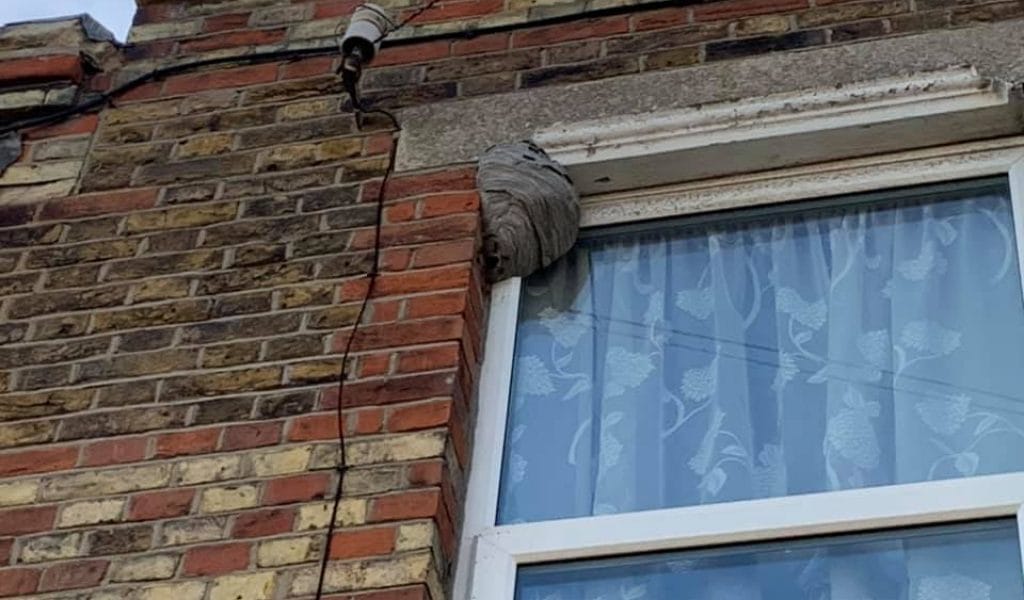
How to keep wasps away?
Now that you know how to control a wasp nest safely, you must consider steps to prevent a future re-infestation. Here are some things you can implement around the home to deter wasps and maintain a pest-free environment.
Block Entry Points: Wasps, other insects, and rodents can enter through small holes in your brickwork in search of food, water and safe shelter. Inspect the exterior of your property to locate and fix unsealed vents, gaps around pipes, foundation cracks or holes in your roof.
Install Fly Screens: Fly screens are a cheap and humane repellent against wasps that will prevent access to your home. Opt for window and door fly screens for maximum protection in the Summer when wasps are most active.
Cover Food: Food in the home, garden or bird feeders work exceptionally well at attracting wasps. Keep your food covered to reduce smells and eliminate the food source to minimise wasp activity.
Burn Citronella Candles: Citronella is a distinctive scent that distracts and confuses wasps, flies, mosquitoes and other insects from the food source. Therefore, you can enjoy your food al fresco by burning citronella candles around your garden—a highly effective repellent to outside pests.
Remove Nests: Some wasps may inhabit old nests the following year. Ensure old nests are removed to minimise the risk of a new colony moving in. It can also indicate weak spots around your home, as nests are typically within close proximity to a previously used entry point.
Correct waste management: Kitchen bins will attract wasps and other pests to your home. Regularly empty rubbish and food waste into your wheelie bin and keep it out of direct sunlight to minimise smells. Wash your bins regularly with hot water and disinfectant to remove odours and neutralise diseases and germs.
Use Essential Oils: Lavender, clove, lemongrass, peppermint, and geranium essential oils are a natural and humane wasp-repellent. In particular, Lavender has a sweet smell that attracts bees but repels problem pests. It contains the active ingredient Linalool which helps to repel yellow jackets, wasps, hornets, flies, fruit flies, bed bugs and fleas.
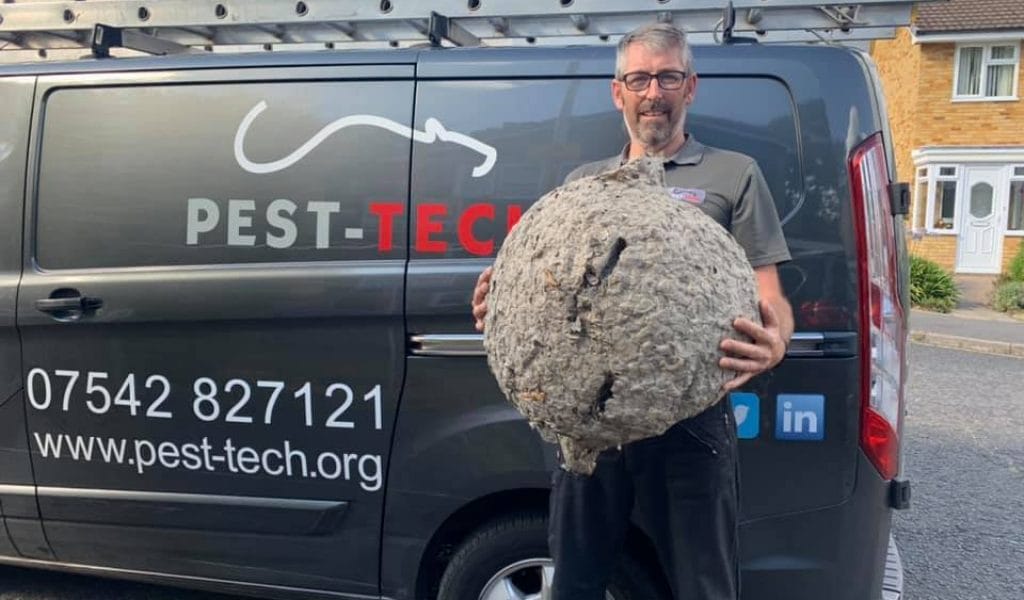
Need Professional Intervention?
DIY wasp nest removals can be time-consuming, frustrating and may require multiple attempts to see results. So when dealing with a wasp’s nest, choosing the expertise and efficiency of a professional pest control company is wise. At Pest-Tech, we combine our pest management experience, knowledge and cutting-edge methods to provide a safe, effective solution with first-time success.
Not only do we implement professional-grade insecticide that kills wasps instantly, but we ensure the entire nest and all wasps are removed. Once our technician controls the wasp nests, we strive to proof your home to prevent wasps from re-entering.
Don’t risk the sting, and contact us today to handle your wasp nest removal needs. Call today at 01622 296055 or email the team at admin@pest-tech.org to book your wasp nest removal in Kent.

